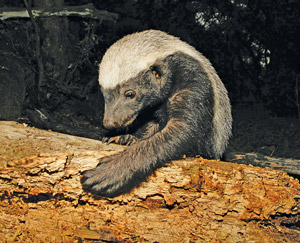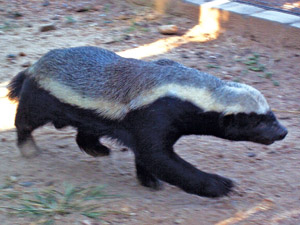|
Nature trail Honey
badgers:
Fearless hunters
Badgers, members of the Mustelidae family are no strangers to us and
some of you may have come across them in story books too as they are
often featured in children's stories and even cartoons. However, the
badger we are featuring today is special because it is considered to be
a very ferocious animal that has even got into the Guinness Book of
World Records as the most fearless animal.
The honey badger (Mellivora capensis or Ratel ) is distributed
throughout most of Africa and western and south Asian areas of
Baluchistan (eastern Iran), southern Iraq, Pakistan and Rajasthan
(western India). It is the only species in the genus Mellivora and the
subfamily Mellivorinae .
Even though it is small in size, it has proved its mite, especially
when it comes to attacking venomous snakes and prey much bigger than it.
So, in order to find out how strong and powerful this little creature is
let's check out its size first. Similar in size and build to the
European badger, Meles meles , honey badgers are heavily built, with a
broad head, small eyes, virtually no external ears, and a relatively
blunt snout. The length from head-and-body ranges from 60 to 102 cm with
a tail of 16 to 30 cm.
The animal's height at the shoulder can be from 23 to 30 cm. The
males sometimes weigh twice as much as the females.The weight range for
females is 5 to 10 kg, while males range from 9 to 14 kg. The underparts,
sides of its body and face are usually dark brown or black in colour,
while the top of its head, neck and back are light grey or white. This
coloration makes the honey badger very prominent during daylight. Some
honey badgers, especially in the Ituri Forest of the Democratic Republic
of Congo, are completely black in colour..
Their small size,however, deceives many would be predators .Most
animals that are bigger than the badger would approach it without any
fear, least suspecting the strength of the animal. For instance, the
honey badger is not afraid to challenge one of the most venomous snakes,
the puff adder whose poison is said kill many people in Africa. It has
been reported in the 2002 National Geographic documentary titled "Snake
killers: Honey badgers of the Kalahari, how one of these creatures
managed to grab food out of a puff adder's mouth. According to the
documentary, the badger stole the meal out of the puff adder's mouth and
casually ate it in front of the hissing snake. Then it turned on the
adder and began to hunt it keeping up to its reputation as one of the
fiercest hunters in its range. It succeeded in killing it and making a
meal out of it but not before the venom of the adder, from bites it
sustained during the hunt, made an impact on the badger. It had suddenly
collapsed while eating,but surprisingly woken up after about two hours
and continued its meal as if nothing had happened.
Don't you think it is amasing that such a small animal could have so
much power to resist being killed by strong snake
|

The badger’s large front claws makes it adept at digging. |
venom? Even though puff adders are among the badger's preferred
venomous snakes, they are not the only animals it hunts. Its prey
includes earthworms, insects, scorpions, porcupines, hares, ground
squirrels, meerkats, mongooses and larger prey such as tortoises,
crocodiles up to one metre in size, young gazelle and snakes (including
pythons and venomous species). It also eats lizards, frogs, small
rodents, birds and fruit. Honey badgers will dig into burrows of small
rodents and flush them out for a small meal. The badger's large front
claws make it adept at digging, and it is usually successful at
capturing rodents. Birds of prey and jackals, aware of the honey
badger's successful hunting strategies, tend to follow badgers and
attempt to steal their kills.
It is also noted for its large appetite for beehives and commercial
honey producers do not take kindly to the destruction of hives by these
animals. Naturally the producers sometimes shoot, trap or poison badgers
they suspect of damaging their hives, although badger-proof commercial
bee hives have been developed.
The honey badger is found in arid grasslands and savannahs. It is a
fierce carnivore with a keen sense of smell.
Even though predominantly solitary, small family groups of up to
three individuals are occasionally seen. It is a nomadic animal and
range over huge areas, which for an adult male may be as large as 600
km2.
Honey badgers are famously tough but they are not indestructible;
lions and leopards routinely kill them and so do some humans, especially
bee producers.
Females have just one offspring at a time, not the multi cub litters
as thought previously. Though they care for their young for more than a
year after birth, half of all cubs succumb to predators or starvation
and die before achieving independence.
The female badger will give birth to a cub after a two months
gestation period. As it grows, it learns to be aggressive to any other
creature (e.g., curious jackals) as it travels across the desert. It
relies on its mother for food and shelter as they regularly move and she
digs new burrows.
|

Small, but ferocious. |
As the little ones can prove to be a hazard when hunting, they are
usually left at the den, where they can be vulnerable. Other honey
badgers may drag cubs from their dens and eat them. Due in part to
cannibalistic threats such as this, only half of badger cubs live to
adulthood. As the cub grows up, its ability to navigate the tough
terrain of the desert improves by learning from its mother to not only
walk, but to also climb trees and to chase snakes.
The badger is not born with these vital skills for survival, they
must be learned. And it has the world's best teacher, its mother, to
teach it all the hunting skills it needs to live up to its reputation.
Once a mother is ready to rear another cub, the other cub is old
enough and skilled enough to survive alone, so it makes its own way in
the world, leaving its mother behind. This happens a few months after
the cub has been born.
Facts and pix:
Internet
*******
Fact file
* Honey badgers are known for their snake-killing abilities; they use
their jaws to grab a snake behind its head and kill it.
* The Endangered Wildlife Trust of South Africa works to save the
honey badger and other African species of animals from extinction. They
sell realistic looking fluffy toys of various African animals including
a mother and baby honey badger.
* Honey badgers can devour a snake (150 cm/5 ft or less) in 15
minutes.
* A 2009 issue of Scientific American claims that pound for pound the
honey badger is the world's most fearsome land mammal due to its
favourable claw to body ratio and aggressive behavioural tendencies.
* Adult honey badgers rarely serve as prey for pythons, wolves,
bears, lions, tigers and leopards; their ferocity and thick, loose skin
makes it difficult to grip or suffocate them. It is able to twist inside
its own skin and bite whatever is holding it.
* Honey badgers are intelligent animals, and are one of few species
capable of using tools. In the 1997 documentary series Land of the
Tiger, a honey badger in India was filmed making use of a tool. The
animal rolled a log and stood on it to reach a kingfisher fledgling
stuck up in the roots coming from the ceiling in an underground cave.
* South Africa's National Defence Force calls its armoured personnel
carriers 'ratels', the Afrikaans word for these beasts.
* A modern fairytale with honey badgers is called 'Honey Badgers' by
Jamison Odone. In this witty tale, a honey badger couple find a human
baby in a basket and decide to adopt him.
* The honey badger is prominent in African myth,
* The Puff Adder (Bitis arietans ) which the honey badger attacks is
considered to be Africa's deadliest snake because it is responsible for
the most human fatalities. Puff Adders reach an average length of around
one metre, and they're solidly built with a wide girth. Colour patterns
vary, depending on where they live, their habitats extend throughout
Africa except for dense rain forests and deserts. The Puff Adder has
large fangs and its venom is powerful enough to kill a grown man with a
single bite. Puff Adders rely on camouflage for protection and lie still
if approached. Because of this, people tend to step on them and get
bitten. Many fatalities occur because bites are not treated correctly,
leading to infection and gangrene. |

